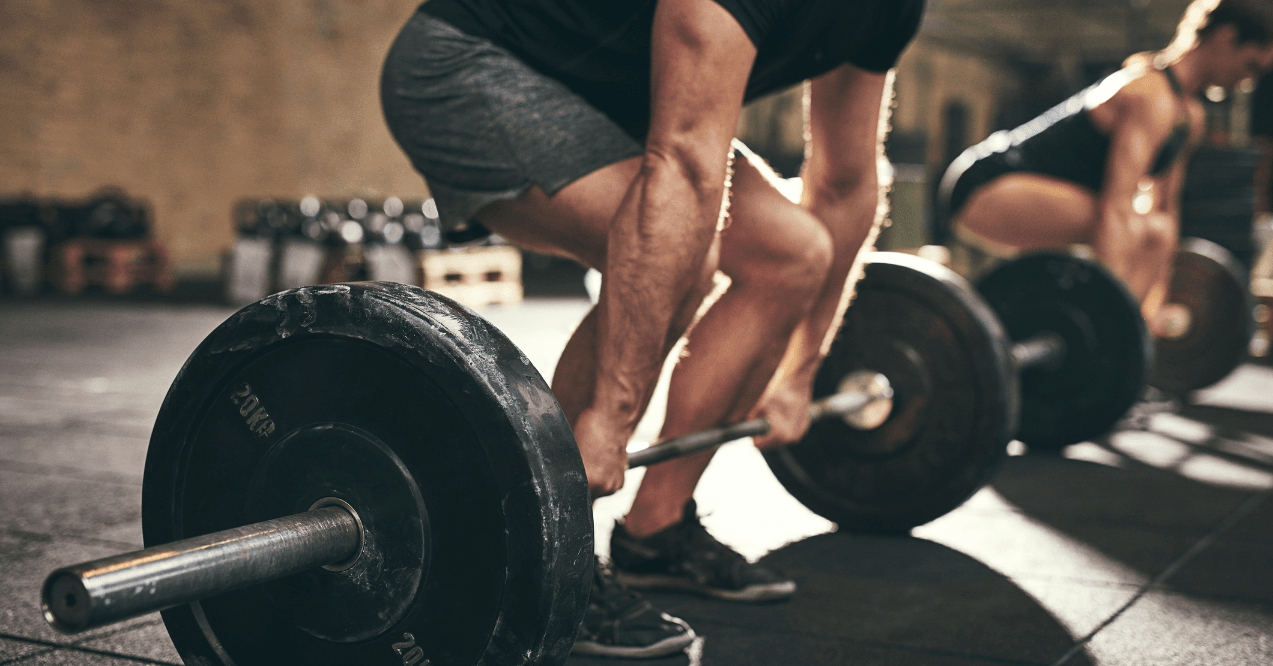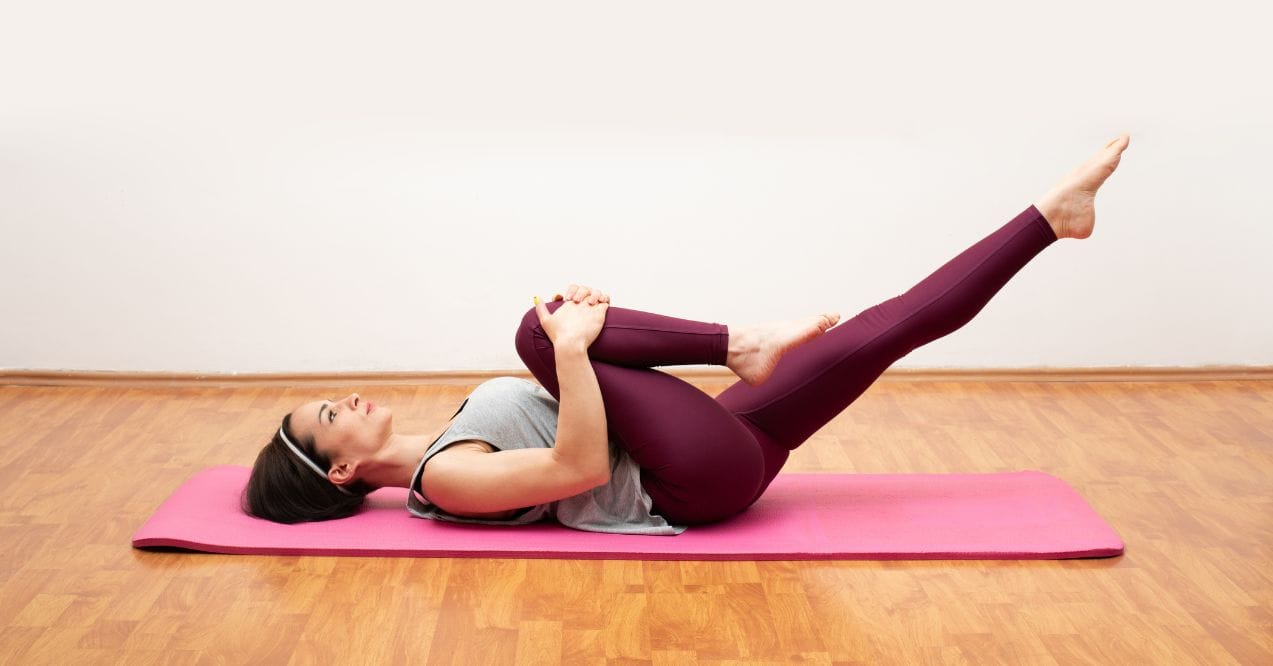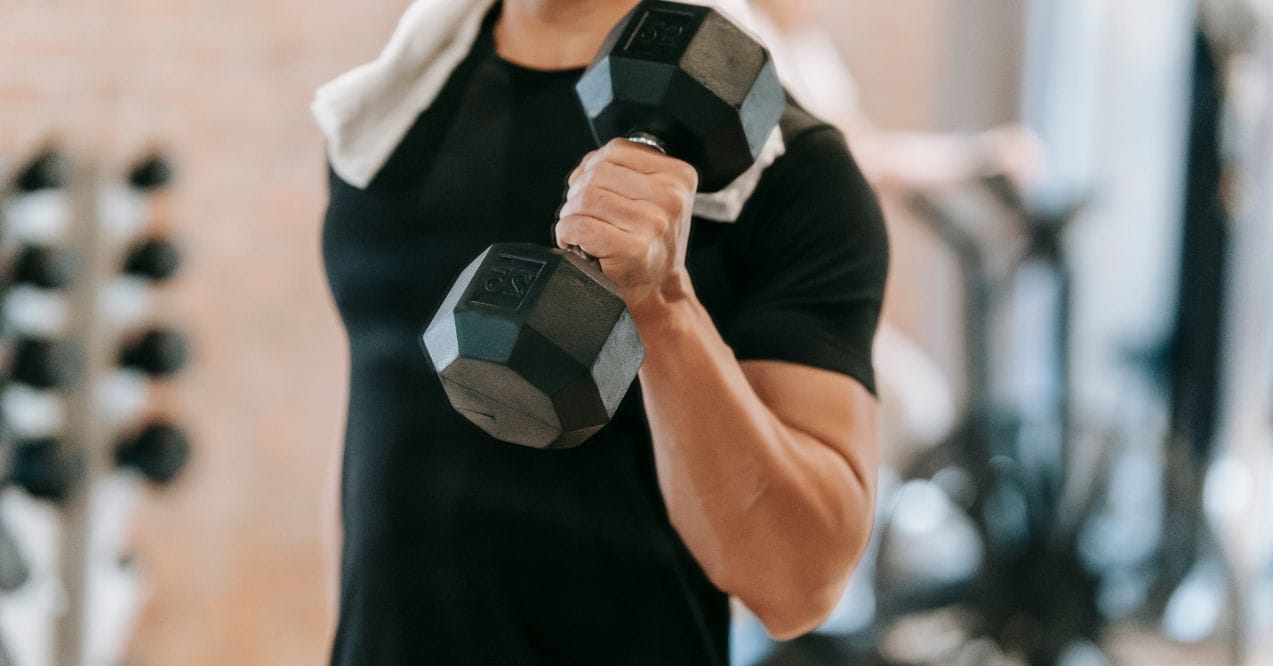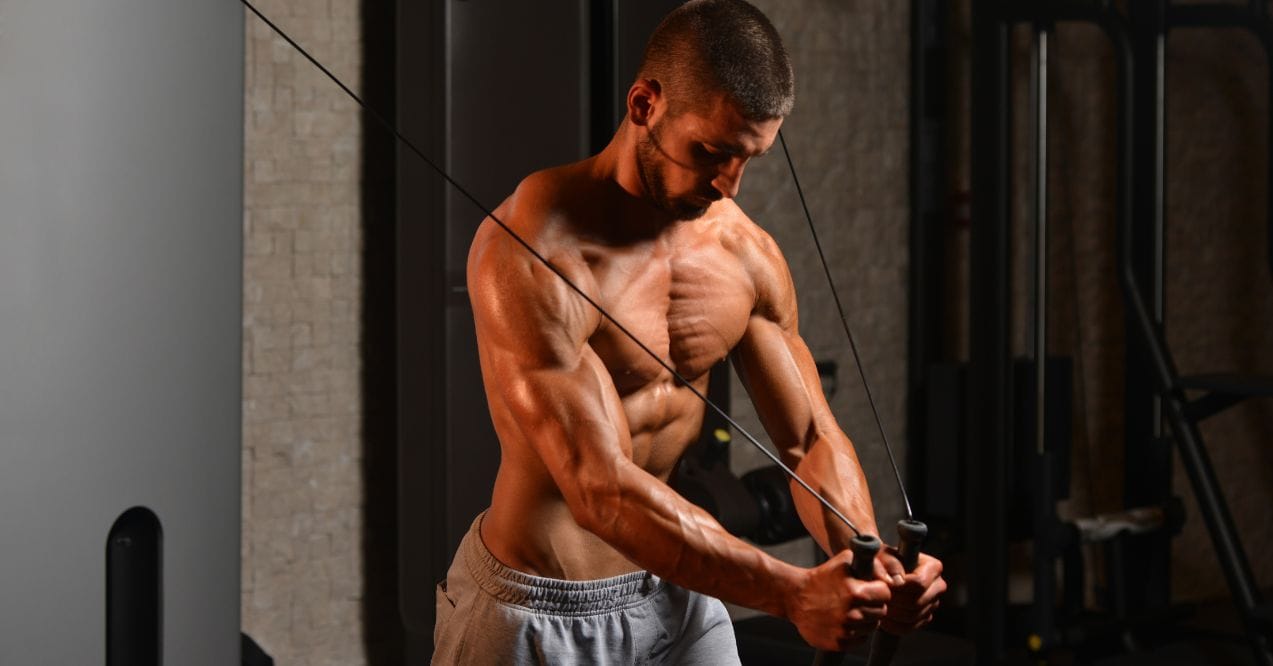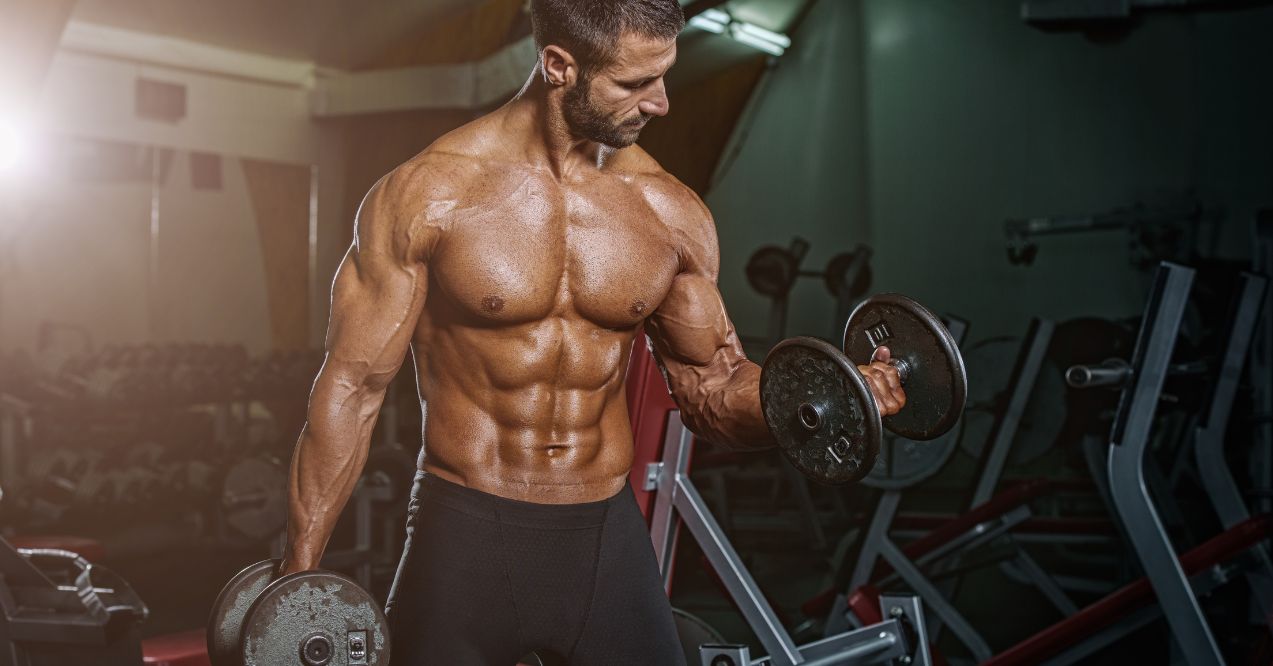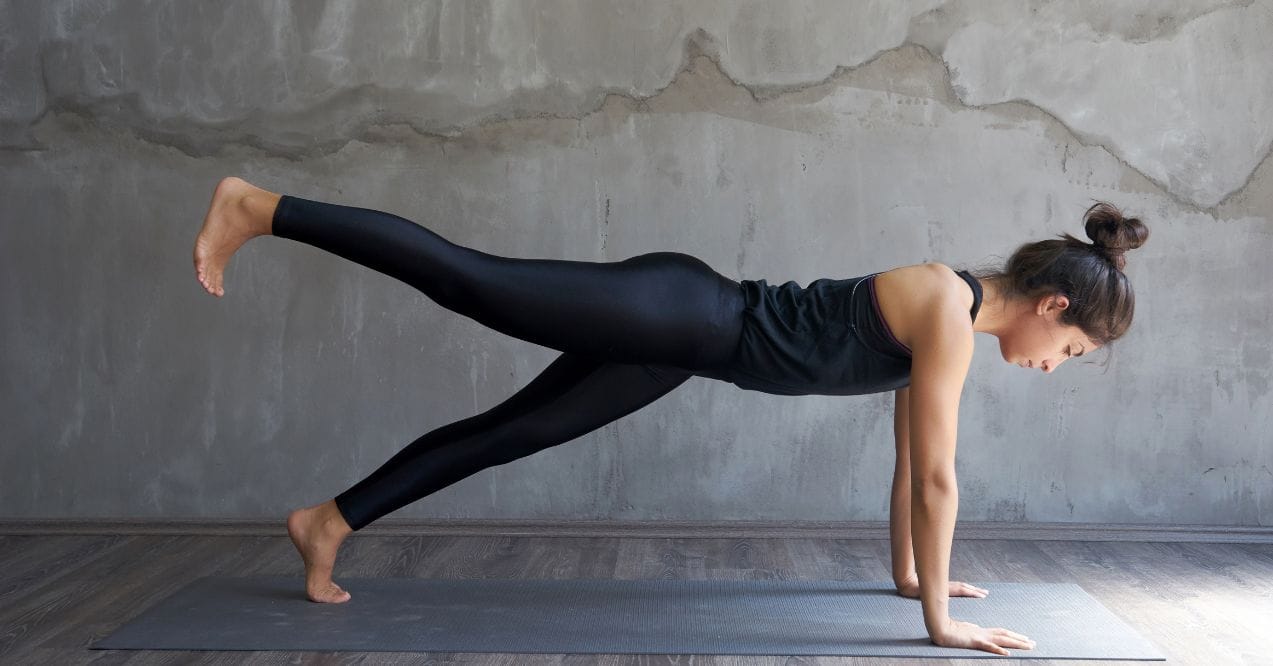10 Effective Chest Cable Exercises for Building Muscle
Looking to sculpt a powerful, well-defined chest? Chest cable exercises offer a game-changing approach to your upper body training. Unlike traditional free weights, cables maintain constant tension throughout each movement, maximizing muscle fiber recruitment and growth potential. This constant resistance can help you understand what is body recomposition – the process of building muscle while reducing fat simultaneously.
Whether you’re a gym veteran or just starting your fitness journey, cable exercises provide unmatched versatility, allowing you to hit your chest from multiple angles while reducing joint stress. Ready to transform your chest workout? These 10 cable exercises will revolutionize your training and help you build the strong, defined chest you’ve been working toward.

Why Choose a Cable Chest Exercises Workout?
When it comes to building an impressive chest, chest workouts with cables offer distinct advantages that traditional free weights simply can’t match. The most significant benefit? Constant tension throughout the entire range of motion. While barbells and dumbbells lose resistance at certain points during exercises, cables keep your muscles working continuously – making them ideal for a time under tension workout approach that stimulates maximum muscle growth.
Many fitness experts consider the cable station the best machine for doing chest exercise due to its unmatched versatility. With adjustable pulleys that can be positioned at various heights, you can target your chest from multiple angles in a single workout session – something impossible with standard bench presses alone.
Cable machines also provide these key benefits:
- Safer progression – Cables allow for smoother weight adjustments without the intimidation factor of loading heavy plates.
- Joint-friendly tension – The consistent resistance reduces peak stress on joints compared to free weights.
- Better isolation – Cables let you focus directly on chest activation without excessive shoulder or tricep takeover.
- Enhanced stabilization – The free-moving cables require core engagement and improve functional strength.
- Greater range of motion – Cables allow your chest muscles to work through a fuller, more complete movement pattern.
Anatomy of the Chest Muscles
Understanding chest anatomy is essential for maximizing your compound chest workout results. The chest consists of several muscles working together to control arm movement and stabilize your upper body.
The pectoralis major is the large, fan-shaped muscle that creates the bulk of your chest. It consists of two distinct sections:
- Clavicular head (upper portion) – Originates at the collarbone and helps with shoulder flexion and bringing your arm across your body.
- Sternal head (lower portion) – The larger section that attaches along your sternum and ribs, powering movements like pushing and pressing.
Beneath the pectoralis major lies the smaller pectoralis minor. Though less visible, this triangular muscle plays a crucial role in stabilizing your shoulder blade and supporting proper posture during chest exercises.
Supporting muscles that engage during chest training include:
- Serratus anterior – The “boxer’s muscle” that runs along your ribs, helping to protract your shoulder blades.
- Anterior deltoids – The front shoulder muscles that assist in pressing movements.
- Triceps – Your arm’s pushing muscles that activate during extension.
The 10 Best Cable Chest Exercises
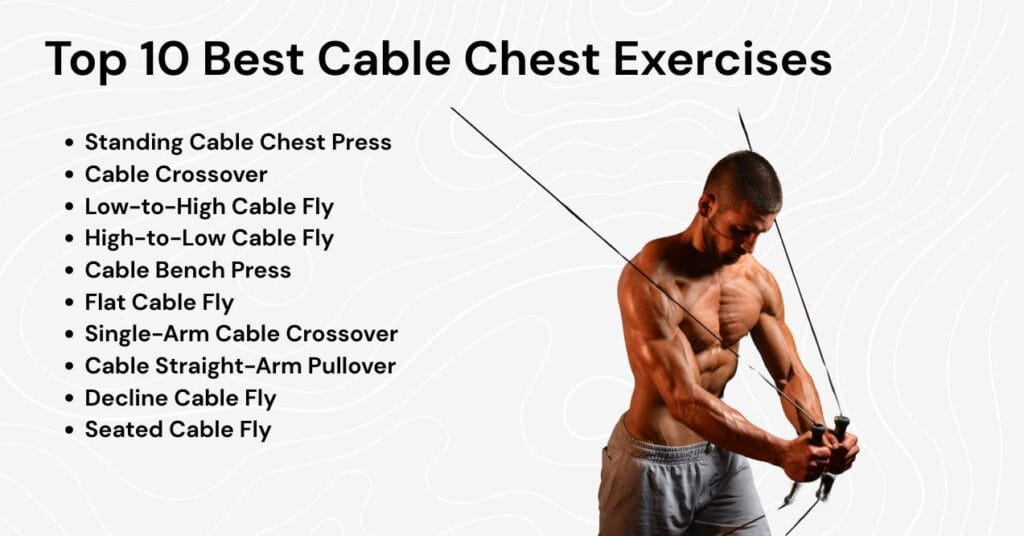
Looking for the ultimate chest development? These best cable chest exercises are scientifically designed to target every fiber of your pectoral muscles from multiple angles. Unlike traditional free weights that create variable resistance patterns, cables maintain constant tension throughout each movement, forcing your chest to work harder with every rep.
Whether you want to build mass, improve definition, or strengthen weak points, this comprehensive collection offers something for everyone. Perfect for creating a complete chest and tricep workout, these exercises will transform your upper body training.
Standing Cable Chest Press
The standing cable chest press serves as the perfect foundation for any cable chest routine. This movement mimics the traditional bench press while adding crucial elements of functional strength and stability.
How to perform:
- Set both pulleys at chest height
- Grab handles with an overhand grip
- Step forward into a split stance for stability
- Press the handles forward until arms are extended
- Slowly return to the starting position with control
What makes this exercise special is the constant tension throughout the movement. Unlike barbell presses where resistance decreases at the top, cables keep your chest engaged through the entire range of motion. The standing position also activates your core as a stabilizer, turning a simple press into a full upper-body exercise that improves functional strength.
Cable Crossover
The chest fly exercise cable crossover is unmatched for creating that coveted chest separation and definition. This exercise allows you to feel a deeper stretch and more intense contraction than nearly any other chest movement.
How to perform:
- Set pulleys to positions slightly above shoulder height
- Grab handles and step forward to center position
- Begin with arms wide and slightly bent
- Pull handles down and across your body until they meet
- Squeeze your chest at the point of contraction
- Return slowly to the stretched position
The crossover motion creates an arc that follows the natural fiber direction of your pectoral muscles. This makes it particularly effective for developing the inner chest area that’s difficult to target with regular pressing movements. The controlled tension throughout the movement makes it ideal for finishing a workout when you want to achieve maximum pump.
Low-to-High Cable Fly
Low cable chest exercises like this are essential for targeting the often-neglected upper chest region. The upward angle of force creates direct stimulation to the clavicular head of the pectoralis major.
How to perform:
- Set cable pulleys to their lowest position
- Grab handles and step forward with a slight lean backward
- Begin with arms down and slightly in front of hips
- Pull the handles upward and inward in an arc motion
- End with hands meeting at upper chest level
- Control the return to starting position
This movement is particularly effective because it applies resistance in the exact opposite direction of gravity’s pull, something that even incline bench presses can’t fully accomplish. For upper chest cable exercises, the upward trajectory creates the perfect stimulus for growth in the upper pectoral fibers.
High-to-Low Cable Fly
The high-to-low fly focuses intensely on the lower and outer chest fibers, creating a comprehensive development that contributes to that powerful chest shelf. This movement is among the best lower chest exercises available.
How to perform:
- Set pulleys to the highest position
- Grab handles and step forward into a stable stance
- Begin with arms high and wide
- Pull handles down and across in a controlled arc
- Bring hands together near hip level
- Return to the start position with deliberate control
The downward pulling motion directly opposes the fiber direction of the lower chest, creating optimal resistance for growth. The upper chest cable positioning provides perfect leverage for targeting the sternal head of the pectoralis major, making this movement essential for complete chest development.
Cable Bench Press
The cable bench press combines the familiar movement pattern of a traditional bench press with the unique constant-tension benefits of cable resistance.
How to perform:
- Position a bench between two cable stations
- Set pulleys to shoulder height
- Lie on the bench and grab handles
- Press the weight upward until arms are extended
- Lower handles with control to chest level
- Repeat while maintaining tension throughout
Unlike barbell or dumbbell presses where tension decreases at certain points, the cables maintain consistent resistance throughout the entire movement. This creates a more intense stimulus for your chest muscles. The cable setup also allows you to bring your hands closer together at the top of the movement, creating additional inner chest activation.
Flat Cable Fly
The flat cable fly serves as an excellent chest fly alternative workout dumbell exercises can’t match for consistent tension. This movement emphasizes the stretch-and-squeeze element that builds chest fullness.
How to perform:
- Position a flat bench between cable stations
- Set pulleys to shoulder height
- Lie on bench holding handles with arms extended
- Lower arms out to sides with slight elbow bend
- Maintain the arc motion until you feel a chest stretch
- Bring handles back together, squeezing chest at the top
The key advantage here is the constant resistance throughout the entire range of motion, particularly at the stretched position where dumbbells lose tension. This creates more effective muscle fiber recruitment and growth stimulus compared to free weights.
Single-Arm Cable Crossover
The one arm cable chest exercises fly movement addresses muscle imbalances while intensifying mind-muscle connection. This unilateral approach allows for greater focus on form and individual chest development.
How to perform:
- Set pulley to shoulder height
- Grab one handle with the working hand
- Step forward with the opposite foot
- Pull the handle across your body in an arc motion
- Squeeze your chest at the point of maximum contraction
- Return slowly to the starting position
- Complete all reps on one side before switching
By working one side at a time, you’ll quickly identify and address strength discrepancies between your left and right pectoral muscles. The single-arm approach also intensifies core engagement as your body works to resist rotation during the movement.
Cable Straight-Arm Pullover
Traditionally performed on a chest pull machine, this cable variation offers superior range of motion control. This unique exercise targets the chest while engaging the lats, creating a comprehensive upper body stimulus.
How to perform:
- Connect a straight or EZ bar attachment to a high pulley
- Face away from the cable station
- Grab the attachment with both hands overhead
- Keep arms straight or slightly bent
- Pull the bar down in an arc until it reaches thigh level
- Return to the starting position with control
This movement creates a powerful stretch at the top position while engaging both the chest and back. The straight-arm component minimizes tricep involvement, directing more tension directly to the chest fibers.
Decline Cable Fly
The decline cable fly targets the lower pectoral fibers with precision, making it one of the best lower chest exercises for creating that defined underside chest shelf.
How to perform:
- Set up a decline bench between cable stations
- Adjust pulleys to a high position
- Lie on the decline bench and grab handles
- Begin with arms extended above chest
- Lower arms out to sides in a wide arc
- Bring handles back together at the bottom of the chest
- Squeeze pecs intensely at the contraction point
The decline angle shifts emphasis to the lower chest region, an area that’s difficult to target with other movements. The cable’s constant tension enhances this effect, creating comprehensive development of the often-neglected lower pectoral region.
Seated Cable Fly
The seated cable fly offers exceptional stability benefits while isolating the chest effectively. This variation is perfect for beginners or those working around certain injuries.
How to perform:
- Position an upright bench between cable stations
- Set pulleys to shoulder height
- Sit facing away from the cables with back supported
- Grab handles with elbows slightly bent
- Bring handles together in front of chest in an arc motion
- Squeeze chest muscles at the point of contraction
- Return to the starting position with control
The seated position removes lower body involvement, forcing your chest to do all the work. The back support also allows you to focus entirely on chest contraction without worrying about core stability, making this an excellent isolation exercise for pure chest development.
Cable Chest Workouts for All Levels
The beauty of cable chest training lies in its scalability. Whether you’re just starting your fitness journey or you’re a seasoned gym veteran, cable exercises can be tailored to match your experience level and goals. The key difference between beginner, intermediate, and advanced workouts isn’t just about adding more exercises – it’s about progressively increasing intensity, complexity, and training volume as your strength and technique improve.
For beginners, the focus remains on mastering fundamental movement patterns with perfect form. Intermediate lifters can start exploring more challenging variations and increased volume. Advanced trainees benefit from incorporating intensity-boosting techniques that push muscles beyond their comfort zone.
Beginner Cable Chest Workout
If you’re new to chest training with cables, this workout emphasizes learning proper form while building a foundation of strength. Perform this routine twice weekly with at least 48 hours between sessions.
Workout Structure:
- Complete 3 sets of each exercise
- Rest 90 seconds between sets
- Use moderate weights that allow 10-12 controlled reps
- Focus on feeling the chest muscles working throughout each movement
Exercise Selection:
Standing Cable Chest Press – 3 sets x 10-12 reps
- Begin with a weight that challenges you by the final rep but allows perfect form
- Focus on keeping shoulders back and chest proud throughout the movement
High-to-Low Cable Fly – 3 sets x 10-12 reps
- Use a lighter weight to master the arc motion
- Concentrate on feeling the stretch at the top and contraction at the bottom
Seated Cable Fly – 3 sets x 10-12 reps
- The seated position helps isolate the chest while providing stability
- Focus on maintaining a slight bend in the elbows throughout the movement
Cable Straight-Arm Pullover – 2 sets x 12-15 reps
- Use very light weight to learn the movement pattern
- Emphasize the stretch at the top position to improve chest flexibility
Intermediate Cable Chest Workout
At the intermediate level, this workout introduces greater variety and volume to stimulate new growth. Perform this routine 1-2 times weekly as part of a broader training split.
Workout Structure:
- Complete 4 sets per exercise
- Rest 60-75 seconds between sets
- Use challenging weights that allow 8-10 quality reps
- Incorporate controlled negatives (3-4 second lowering phase)
Exercise Selection:
Cable Bench Press – 4 sets x 8-10 reps
- Use a weight that challenges you by rep 8
- Focus on full range of motion and controlled movement
Low-to-High Cable Fly – 4 sets x 10-12 reps
- Emphasize the contraction at the top of the movement
- Keep tension on the chest throughout the entire set
Standing Cable Chest Press (Single Arm) – 3 sets x 10 reps each arm
- Adds core stability challenge and addresses muscle imbalances
- Focus on preventing torso rotation during the press
Cable Crossover – 3 sets x 10-12 reps
- Perform with controlled tempo (2 count press, 1 count hold, 3 count return)
- Squeeze chest muscles intensely at the point of contraction
Flat Cable Fly – 3 sets x 12 reps
- Perfect as a finisher to achieve maximum chest pump
- Focus on the stretch-and-squeeze contrast for growth stimulus
Advanced Cable Chest Workout
This advanced routine incorporates intensity-boosting techniques and complex movement patterns for continued progress. Perform once weekly as part of an upper body or push-focused training day.
Workout Structure:
- Implement advanced training techniques (noted for each exercise)
- Rest 45-60 seconds between sets (except where noted)
- Use heavy weights while maintaining proper technique
- Focus on maximum muscle fiber recruitment through varied rep ranges
Exercise Selection:
Cable Bench Press – 5 sets using pyramid protocol:
- Set 1: 15 reps (moderate weight)
- Set 2: 12 reps (increase weight)
- Set 3: 10 reps (increase weight)
- Set 4: 8 reps (increase weight)
- Set 5: 6 reps (maximum challenging weight)
Standing Cable Chest Press superset with Cable Crossover – 4 rounds:
- Standing Cable Press: 8-10 reps (heavy)
- Immediately transition to Cable Crossover: 12-15 reps (moderate)
- Rest 90 seconds after completing both exercises
Single-Arm Cable Crossover – 3 sets x 12 reps each side
- Advanced technique: Add a 2-second hold at peak contraction
- Focus on maximum range of motion and chest isolation
Low-to-High Cable Fly – 4 sets x 10-12 reps
- Advanced technique: Drop set on final set (reduce weight by 30% after failure and continue)
- Emphasize controlled eccentric phase throughout
Decline Cable Fly followed by Straight-Arm Pullover – 3 giant sets:
- Decline Cable Fly: 10-12 reps
- Immediately transition to Straight-Arm Pullover: 10-12 reps
- Rest 2 minutes after completing both exercises
High-to-Low Cable Fly – 2 sets x 15-20 reps
- Use lighter weight as a finisher
- Focus on continuous tension and pump to flood muscles with blood
This progressive approach ensures that regardless of your experience level, you’ll have a structured path forward for continued chest development using cable exercises.
Pro Tips for Cable Chest Training
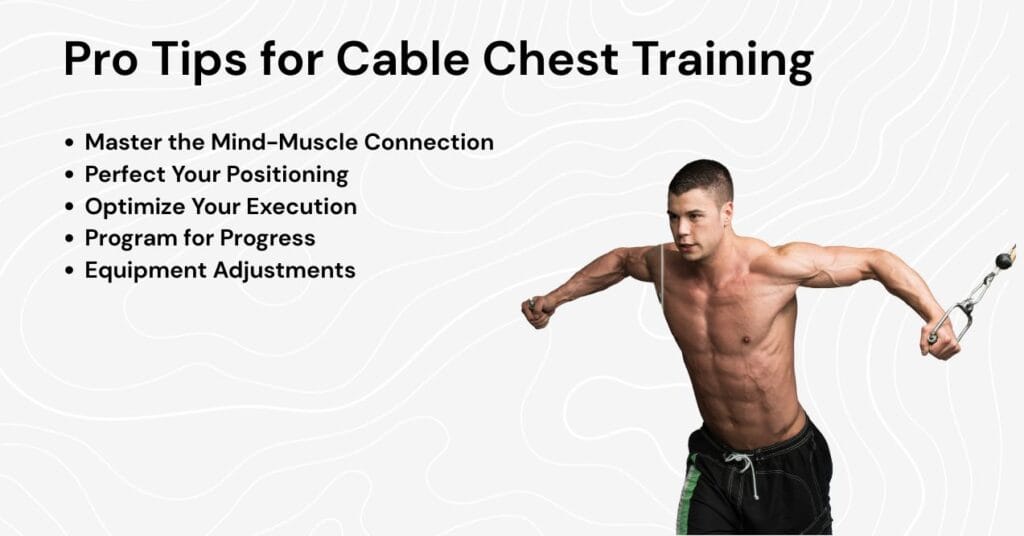
Take your chest cable exercises to the next level with these expert strategies that can dramatically improve your results:
Master the Mind-Muscle Connection
- Perform your first set with lighter weight, focusing exclusively on feeling your chest muscles contract and stretch
- Briefly touch your working pectoral with your opposite hand during initial reps to enhance muscle awareness
- Maintain a slight pause at peak contraction to maximize fiber recruitment
Perfect Your Positioning
- Establish a stable base with feet shoulder-width apart and core engaged
- Position yourself far enough from the cable station to maintain tension throughout the entire range of motion
- Adjust pulley heights precisely to target specific chest regions – even small changes can shift muscle emphasis significantly
Optimize Your Execution
- Control the eccentric (lowering) phase for 3-4 seconds to increase time under tension
- Keep shoulders pulled back and down to prevent front deltoid takeover
- Maintain a slight bend in the elbows during fly movements to protect joints while maximizing chest activation
Program for Progress
- Rotate between rep ranges (6-8, 10-12, and 15-20) to stimulate different muscle fiber types
- Incorporate unilateral movements to address left-right imbalances
- Schedule dedicated cable chest workouts no more than twice weekly to allow for proper recovery
Equipment Adjustments
- Experiment with different attachments (handles, ropes, bars) to find what creates the strongest chest activation for your body
- Use a resistance band wrapped around your back during pressing movements for added tension at the contracted position
For optimal results from your cable chest training, proper nutrition is crucial. Bone Broth Protein powder provides the perfect post-workout solution with 20 grams of clean protein per serving. Its collagen-rich formula specifically supports joint comfort during pressing movements while promoting faster recovery between chest sessions.
Unlike conventional protein supplements, Bone Broth Protein amino acid profile helps maintain chest muscle integrity and repair the micro-tears created during intense cable workouts, allowing you to train with greater frequency and intensity.
Conclusion
Chest cable exercises represent one of the most effective approaches to building a powerful, well-defined chest. By incorporating these ten movements into your training regimen, you’ll target every angle of your pectoral muscles while maintaining constant tension throughout each rep. The versatility of cable training allows for endless progression possibilities regardless of your current fitness level.
Remember that consistency trumps intensity – focus on proper form, appropriate weight selection, and strategic programming to see lasting results. Whether you’re just beginning your fitness journey or looking to break through a plateau, these cable chest exercises provide the perfect stimulus for continued growth and development.
Cable chest exercises maintain constant tension throughout the entire movement, targeting more muscle fibers than free weights. They also allow training from multiple angles, increasing muscle activation while reducing joint stress and improving mind-muscle connection.
Train your chest with cables 1-2 times weekly, allowing 48-72 hours between sessions for optimal recovery. Beginners can start with twice weekly, while advanced lifters might incorporate one heavy and one lighter cable session per week.
Yes, cable exercises can effectively replace bench press in your routine. Movements like the cable chest press provide similar benefits with added advantages of constant tension, greater range of motion, and reduced joint stress.
Advertisement. This site offers health, wellness, fitness and nutritional information and is designed for educational purposes only. You should not rely on this information as a substitute for, nor does it replace, professional medical advice, diagnosis, or treatment. If you have any concerns or questions about your health, you should always consult with a physician or other health-care professional. Do not disregard, avoid or delay obtaining medical or health related advice from your health-care professional because of something you may have read on this site. The use of any information provided on this site is solely at your own risk.
